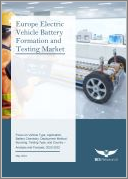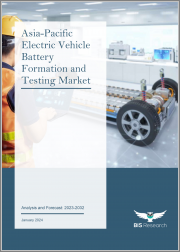
|
시장보고서
상품코드
1484378
유럽의 전기자동차 배터리 포메이션 및 테스트 시장 : 차량 유형별, 용도별, 배터리 화학별, 전개 방식별, 조달별, 테스트 유형별, 국가별 - 분석 및 예측(2023-2032년)Europe Electric Vehicle Battery Formation and Testing Market: Focus on Vehicle Type, Application, Battery Chemistry, Deployment Method, Sourcing, Testing Type, and Country - Analysis and Forecast, 2023-2032 |
||||||
유럽의 전기자동차 배터리 포메이션 및 테스트 시장 규모(영국 제외)는 2023년 2억 2,760만 달러에 달했습니다.
이 시장은 향후 16.76%의 CAGR로 성장하여 2032년에는 9억 1,770만 달러 규모에 이를 것으로 예측됩니다. 전기자동차(EV)의 수요 증가와 EV 배터리의 안전성, 신뢰성, 성능에 대한 검증의 필요성이 시장 성장을 견인할 것으로 예상되며, EV의 보급이 가속화됨에 따라 배터리 제조업체들은 엄격한 안전 기준을 준수하는 고품질 배터리를 생산해야 하는 과제에 직면하고 있습니다.
| 주요 시장 통계 | |
|---|---|
| 예측 기간 | 2023-2032년 |
| 2023년 평가액 | 2억 2,760만 달러 |
| 2032년 전망 | 9억 1,770만 달러 |
| CAGR | 16.76% |
유럽의 전기자동차(EV) 배터리 포메이션 및 테스트 시장은 EU의 엄격한 배기가스 규제와 전동화 추세에 힘입어 강력한 성장세를 보이고 있습니다. 유럽 국가들이 탄소 발자국을 줄이기 위해 노력하면서 전기차에 대한 수요가 급증하고 있으며, 안전 및 성능 표준을 보장하기 위해 첨단 배터리 테스트 및 형성 공정이 요구되고 있습니다. 이 지역의 주요 기업들은 배터리 수명과 효율성을 향상시키는 테스트 방법을 혁신하기 위해 연구개발에 많은 투자를 하고 있습니다. 또한, 자동차 제조업체와 기술 제공업체와의 협력 관계는 최첨단 테스트 시설의 개발을 촉진하고 있습니다. 이 시장은 또한 전기차 도입에 대한 정부 보조금과 첨단 제조 기지 설립으로 뒷받침되고 있으며, 유럽은 지속가능한 교통수단으로의 전환에 있어 선도적인 위치를 점하고 있습니다.
이 보고서는 유럽의 전기자동차 배터리 포메이션 및 테스트 시장을 조사했으며, 시장 개요와 함께 차량 유형별, 용도별, 배터리 화학별, 전개 방식별, 조달별, 테스트 유형별, 국가별 동향, 시장 진입 기업 개요 등을 정리하여 전해드립니다.
목차
주요 요약
조사 범위
제1장 시장
- 업계 전망
- 비즈니스 역학
제2장 지역
- 유럽
- 영국
제3장 시장 - 경쟁 벤치마킹과 기업 개요
- 경쟁 벤치마킹
- 시장 점유율 분석
- 제품/서비스 매트릭스
- 기업 개요
- Siemens AG
- ABB
- SAP SE
- Dassault Systemes
- AVEVA Group Limited
- Tulip Batteries
- TUV SUD
- Infineon Technologies AG
- Element Materials Technology
- 기타 주요 기업
제4장 조사 방법
ksm 24.06.03Introduction to Europe Electric Vehicle Battery Formation and Testing Market
The Europe electric vehicle battery formation and testing market (excluding U.K.) was valued at $227.6 million in 2023, and it is expected to grow at a CAGR of 16.76% and reach $917.7 million by 2032. The growth of the electric vehicle battery formation and testing market is anticipated to be propelled by the increasing demand for electric vehicles (EVs) and the necessity to verify the safety, reliability, and performance of EV batteries. With the rapid acceleration in EV adoption, battery manufacturers face the challenge of producing high-quality batteries that adhere to rigorous safety standards.
| KEY MARKET STATISTICS | |
|---|---|
| Forecast Period | 2023 - 2032 |
| 2023 Evaluation | $227.6 Million |
| 2032 Forecast | $917.7 Million |
| CAGR | 16.76% |
Market Introduction
The Europe market for electric vehicle (EV) battery formation and testing is experiencing robust growth, driven by stringent EU regulations on emissions and a strong push towards electrification. As European nations commit to reducing their carbon footprint, the demand for EVs has surged, necessitating advanced battery testing and formation processes to ensure safety and performance standards. Key players in the region are investing heavily in R&D to innovate testing methodologies that enhance battery life and efficiency. Moreover, collaborations between automotive manufacturers and technology providers are fostering the development of state-of-the-art testing facilities. This market is further supported by government incentives for EV adoption and the establishment of high-tech manufacturing hubs, positioning Europe as a leader in the shift towards sustainable transportation.
Market Segmentation:
Segmentation 1: by Application
- Manufacturing
- Testing
Segmentation 2: by Vehicle Type
- Passenger Vehicle
- Commercial Vehicle
Segmentation 3: by Battery Chemistry
- Lithium-Ion
- Others
Segmentation 4: by Sourcing Type
- In-house
- Outsourcing
Segmentation 5: by Deployment Method
- Cloud-Based
- On-Premises
Segmentation 6: by Testing Type
- Mechanical Tests
- Thermal Tests
- Electrical Tests
- Others
Segmentation 7: by Country
- Germany
- Hungary
- Poland
- Sweden
- Rest-of-Europe
How can this report add value to an organization?
Product/Innovation Strategy: The product/innovation strategy for companies in the electric vehicle battery formation and testing market should focus on continuous improvement, differentiated solutions, collaboration, automation, cost reduction, regulatory compliance, talent acquisition, and intellectual property protection. Companies should continuously invest in research and development to stay ahead of the curve, develop specialized testing equipment, partner with industry stakeholders, leverage automation and data analytics, focus on cost-effective battery chemistries, stay informed on regulatory standards, attract, and retain top talent, and protect their intellectual property. By following these key strategies, companies can position themselves for success in this growing and dynamic market.
Growth/Marketing Strategy: The electric vehicle battery formation and testing market has been growing at a rapid pace. The market offers enormous opportunities for existing and emerging market players. Some of the strategies covered in this segment are mergers and acquisitions, product launches, partnerships and collaborations, business expansions, and investments. The strategies preferred by companies to maintain and strengthen their market position primarily include partnerships, agreements, and collaborations.
Competitive Strategy: The competitive strategy for companies in the electric vehicle battery formation and testing market should be focused on differentiation, cost leadership, and customer focus. Companies should differentiate their products and services by developing specialized testing equipment, offering value-added services, and collaborating with industry partners. They should also focus on cost reduction by developing more efficient manufacturing processes and using less expensive materials. Finally, companies should focus on providing excellent customer service and support to build strong customer relationships. By focusing on these three key areas, companies can gain a competitive edge in the electric vehicle battery formation and testing market.
Key Market Players and Competition Synopsis
The companies that are profiled have been selected based on inputs gathered from primary experts and analyzing company coverage, product portfolio, and regional presence.
Some of the prominent names in this market are:
- Siemens AG
- ABB
- SAP SE
- Dassault Systemes
- Tulip Batteries
- TUV SUD
- Infineon Technologies AG
Table of Contents
Executive Summary
Scope of the Study
1 Markets
- 1.1 Industry Outlook
- 1.1.1 Trends: Current and Future
- 1.1.1.1 Growing Demand for High-Performance and Reliable Electric Vehicle (EV) Batteries
- 1.1.1.2 Strategic Business Strategies to Enhance Presence in the Electric Vehicle Battery Formation and Testing Market
- 1.1.2 Technology Roadmap
- 1.1.3 Ecosystem/Ongoing Programs
- 1.1.3.1 Consortiums, Associations, and Regulatory Bodies
- 1.1.3.2 Government Initiatives
- 1.1.3.3 Programs by Research Institutions and Universities
- 1.1.4 Key Patent Mapping
- 1.1.4.1 Patent Analysis (by Status)
- 1.1.1 Trends: Current and Future
- 1.2 Business Dynamics
- 1.2.1 Business Drivers
- 1.2.1.1 Growing Adoption and Utilization of Electric Vehicles
- 1.2.1.2 Improving Electric Vehicle Performance through Accurate Battery Testing
- 1.2.1.3 Stringent Government Regulations on EV Battery Safety and Performance
- 1.2.2 Business Restraints
- 1.2.2.1 Less Adoption of EVs in Many Underdeveloped and Developing Countries
- 1.2.2.2 Supply Chain Uncertainties and Lack of Charging Infrastructure
- 1.2.3 Business Opportunities
- 1.2.3.1 Growing Usage of Emerging Technologies for Battery Testing
- 1.2.3.2 Increase in the Number of Battery Failure Cases in Electric Vehicles
- 1.2.1 Business Drivers
2 Regions
- 2.1 Europe
- 2.1.1 Europe: Country-Level Analysis
- 2.1.1.1 Germany
- 2.1.1.2 Sweden
- 2.1.1.3 Poland
- 2.1.1.4 Hungary
- 2.1.1.5 Rest-of-Europe
- 2.1.1 Europe: Country-Level Analysis
- 2.2 U.K.
3 Markets - Competitive Benchmarking & Company Profiles
- 3.1 Competitive Benchmarking
- 3.2 Market Share Analysis
- 3.3 Product/Service Matrix
- 3.4 Company Profiles
- 3.4.1 Siemens AG
- 3.4.1.1 Company Overview
- 3.4.1.2 Product Portfolio
- 3.4.1.3 Analyst View
- 3.4.1.3.1 Regions of Growth
- 3.4.2 ABB
- 3.4.2.1 Company Overview
- 3.4.2.2 Product Portfolio
- 3.4.2.3 Analyst View
- 3.4.2.3.1 Regions of Growth
- 3.4.3 SAP SE
- 3.4.3.1 Company Overview
- 3.4.3.2 Analyst View
- 3.4.3.2.1 Regions of Growth
- 3.4.4 Dassault Systemes
- 3.4.4.1 Company Overview
- 3.4.4.2 Product Portfolio
- 3.4.4.3 Analyst View
- 3.4.4.3.1 Regions of Growth
- 3.4.5 AVEVA Group Limited
- 3.4.5.1 Company Overview
- 3.4.5.2 Product Portfolio
- 3.4.5.3 Analyst View
- 3.4.5.3.1 Regions of Growth
- 3.4.6 Tulip Batteries
- 3.4.6.1 Company Overview
- 3.4.6.2 Product Portfolio
- 3.4.6.3 Analyst View
- 3.4.6.3.1 Regions of Growth
- 3.4.7 TUV SUD
- 3.4.7.1 Company Overview
- 3.4.7.2 Product Portfolio
- 3.4.7.3 Analyst View
- 3.4.7.3.1 Regions of Growth
- 3.4.8 Infineon Technologies AG
- 3.4.8.1 Company Overview
- 3.4.8.2 Product Portfolio
- 3.4.8.3 Analyst View
- 3.4.8.3.1 Regions of Growth
- 3.4.9 Element Materials Technology
- 3.4.9.1 Company Overview
- 3.4.9.2 Product Portfolio
- 3.4.9.3 Analyst View
- 3.4.9.3.1 Regions of Growth
- 3.4.1 Siemens AG
- 3.5 Other Key Companies
4 Research Methodology
- 4.1 Data Sources
- 4.1.1 Primary Data Sources
- 4.1.2 Secondary Data Sources
- 4.2 Data Triangulation
- 4.3 Market Estimation and Forecast
- 4.3.1 Factors for Data Prediction and Modeling













